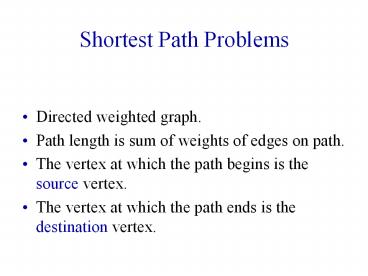Shortest Path Problems - PowerPoint PPT Presentation
Title:
Shortest Path Problems
Description:
Title: Data Representation Methods Author: Preferred Customer Last modified by: sahni Created Date: 6/17/1995 11:31:02 PM Document presentation format – PowerPoint PPT presentation
Number of Views:225
Avg rating:3.0/5.0
Title: Shortest Path Problems
1
Shortest Path Problems
- Directed weighted graph.
- Path length is sum of weights of edges on path.
- The vertex at which the path begins is the source
vertex. - The vertex at which the path ends is the
destination vertex.
2
Example
8
6
2
1
3
3
1
16
7
5
6
10
4
4
2
4
7
5
3
14
- A path from 1 to 7.
Path length is 14.
3
Example
8
6
2
1
3
3
1
16
7
5
6
10
4
4
2
4
7
5
3
14
- Another path from 1 to 7.
Path length is 11.
4
Shortest Path Problems
- Single source single destination.
- Single source all destinations.
- All pairs (every vertex is a source and
destination).
5
Single Source Single Destination
- Possible algorithm
- Leave source vertex using cheapest/shortest edge.
- Leave new vertex using cheapest edge subject to
the constraint that a new vertex is reached. - Continue until destination is reached.
6
Constructed 1 To 7 Path
8
6
2
1
3
3
1
16
7
5
6
10
4
4
2
4
7
5
3
14
Path length is 12. Not shortest path. Algorithm
doesnt work!
7
Single Source All Destinations
- Need to generate up to n (n is number of
vertices) paths (including path from source to
itself). - Dijkstras method
- Construct these up to n paths in order of
increasing length. - Assume edge costs (lengths) are gt 0.
- So, no path has length lt 0.
- First shortest path is from the source vertex to
itself. The length of this path is 0.
8
Single Source All Destinations
8
6
2
1
3
3
1
16
7
5
6
10
4
4
2
4
7
5
3
14
Path
Length
9
Single Source All Destinations
Length
Path
- Each path (other than first) is a one edge
extension of a previous path. - Next shortest path is the shortest one edge
extension of an already generated shortest path.
1
0
2
1
3
1
3
5
5
10
Single Source All Destinations
- Let di be the length of a shortest one edge
extension of an already generated shortest path,
the one edge extension ends at vertex i. - The next shortest path is to an as yet unreached
vertex for which the d value is least. - Let pi be the vertex just before vertex i on
the shortest one edge extension to i.
11
Single Source All Destinations
8
6
2
1
3
3
1
16
7
5
6
10
4
4
2
4
7
5
3
14
0
6
2
16
-
-
14
-
1
1
1
-
-
1
12
Single Source All Destinations
8
6
2
1
3
3
1
16
7
5
6
10
4
4
2
4
7
5
3
14
5
0
6
2
16
-
-
14
-
1
1
1
-
-
1
13
Single Source All Destinations
8
6
2
1
3
3
1
16
7
5
6
10
4
4
2
4
7
5
3
14
0
6
2
16
-
-
14
6
-
1
1
1
-
-
1
14
Single Source All Destinations
8
6
2
1
3
3
1
16
7
5
6
10
4
4
2
4
7
5
3
14
0
6
2
9
-
-
14
9
-
1
1
5
-
-
1
15
Single Source All Destinations
8
6
2
1
3
3
1
16
7
5
6
10
4
4
2
4
7
5
3
14
10
0
6
2
9
-
-
14
-
1
1
5
-
-
1
16
Single Source All Destinations
8
6
2
1
3
3
1
16
7
5
6
10
4
4
2
4
7
5
3
14
0
6
2
9
-
-
14
-
1
1
5
-
-
1
17
Single Source All Destinations
18
Source Single Destination
- Terminate single source all destinations
algorithm as soon as shortest path to desired
vertex has been generated.
19
Data Structures For Dijkstras Algorithm
- The described single source all destinations
algorithm is known as Dijkstras algorithm. - Implement d and p as 1D arrays.
- Keep a linear list L of reachable vertices to
which shortest path is yet to be generated. - Select and remove vertex v in L that has smallest
d value. - Update d and p values of vertices adjacent to
v.
20
Complexity
- O(n) to select next destination vertex.
- O(out-degree) to update d and p values when
adjacency lists are used. - O(n) to update d and p values when adjacency
matrix is used. - Selection and update done once for each vertex to
which a shortest path is found. - Total time is O(n2 e) O(n2).
21
Complexity
- When a min heap of d values is used in place of
the linear list L of reachable vertices, total
time is O((ne) log n), because O(n) remove min
operations and O(e) change key (d value)
operations are done. - When e is O(n2), using a min heap is worse than
using a linear list. - When a Fibonacci heap is used, the total time is
O(n log n e).































